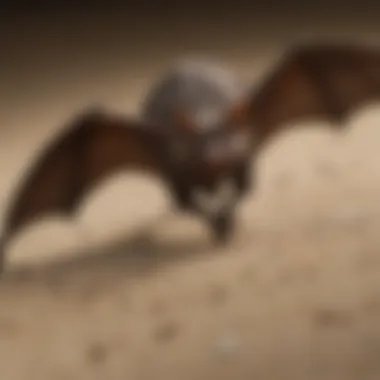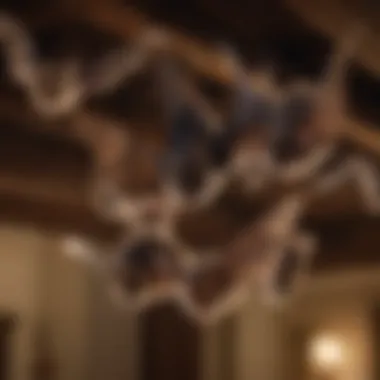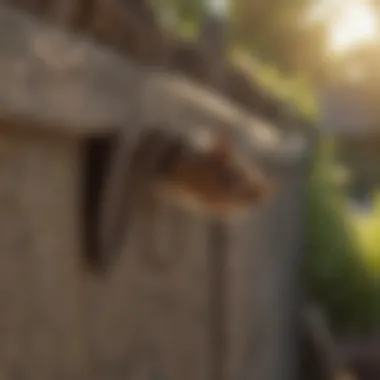Effective Strategies to Deter Bats from Your Home


Intro
Bats are fascinating creatures, yet their presence in residential areas can lead to various concerns for homeowners. Understanding and managing bats requires a comprehensive approach that respects both the creatures and the environment. This article explores various strategies to deter bats from settling in or around your home. We will delve into their behavior, biological traits, and the best methods for prevention. Emphasizing eco-friendly practices, the goal is to empower homeowners to take effective action while complying with legal protections that apply to these unique mammals.
Understanding the Pest
Identification
It is essential to accurately identify the species of bats that may inhabit your area. Common species include the Little Brown Bat and the Big Brown Bat. These species are small, nocturnal, and often roost in colonies. Signs of a bat infestation include droppings, which resemble small black pellets, and audible chirping or squeaking sounds at dusk. Familiarity with identifying features, such as wing shape and fur color, can aid in recognizing bats in proximity to your home.
Life Cycle
These mammals typically breed in the spring, with most species giving birth to one pup each summer. After two months, young bats are capable of flight. Bats can live for several years, sometimes even up to two decades. The seasonal habits also play a significant role in their presence. They tend to roost in warm locations during colder months and seek shelter in attics, eaves, and other secluded areas of homes during breeding season.
Pest Prevention Strategies
Environment Modification
One of the most effective ways to prevent bats from entering your residence is through environmental modifications. This includes:
- Clearing away debris that may serve as nesting sites, such as piles of wood or old building materials.
- Keeping the lawn well-manicured to limit hiding places.
- Sealing and removing potential food sources like open trash or uncovered compost bins.
Adequate lighting around the house can also deter bats since they prefer dark and secluded spaces.
Physical Barriers
Installing physical barriers is a critical strategy in preventing bat entry. Some recommendations include:
- Sealing gaps around windows, doors, and chimneys with caulk or metal mesh.
- Adding screens to vents and other openings to block access.
- Utilizing bat houses as an alternative roosting option, redirecting them away from your home.
By implementing these measures, homeowners can significantly reduce the likelihood of bats taking residence in unwanted areas.
Control Methods
Chemical Control
Although it is generally advised to avoid chemical interventions, understanding the available options is necessary. Pesticides meant for other pests may inadvertently affect bats. Chemical repellents formulated for bats exist, yet their effectiveness can be limited, requiring frequent reapplication and caution not to harm the bats themselves.
Biological Control
Natural predators can help manage bat populations. However, this strategy may not be applicable for all residential settings, and habitat management should always aim for sustainability. Encouraging raptor populations or other natural predators through proper habitats might influence bat presence.
"Remember that it is crucial to respect bats and their legal protections, so explore non-lethal methods first."
The approach to managing bats involves a multidimensional understanding of their habits and ecological roles. By adopting preventive strategies and utilizing physical barriers, homeowners can safeguard their living spaces from unwanted bat inhabitants.
Understanding Bats
Understanding bats is crucial for homeowners who wish to protect their living spaces from these flying mammals. Bats play an important role in the ecosystem, including pest control and pollination. However, when they invade residential areas, they can cause noise, damage, and pose health risks. This article provides an insightful look into bat biology, species, and behavior, empowering readers to appreciate bats while also guarding their homes against unwanted infestation.
Basic Bat Biology
Bats belong to the order Chiroptera, which means 'winged hands'. They are the only mammals capable of sustained flight, with their wings formed from a thin membrane of skin stretched between elongated finger bones. Bats have a highly developed echolocation system, allowing them to navigate and hunt in the dark by emitting sounds and listening for the returning echoes.
Understanding their biology helps in recognizing their needs and behavior patterns. For instance, bats typically roost in colonies, making them social creatures. They primarily feed on insects, fruits, and nectar, depending on the species, contributing to the natural balance in their environments.
Bat Species Commonly Found in Urban Areas
Different species of bats inhabit urban areas, each with distinct characteristics:
- Little Brown Bat: Known for their small size and remarkable adaptability. They often roost in buildings.
- Big Brown Bat: Larger than the Little Brown, they can thrive in various environments, including homes.
- Mexican Free-Tailed Bat: Recognizable for their swift flight, they often roost in attics and gaps.


Being aware of these species helps homeowners to identify potential risks and choose appropriate prevention strategies. Each species may behave differently, influencing how they enter structures and establish roosting sites.
Bat Behavior and Habits
Bats have unique behaviors that are important for understanding their habits. They are nocturnal and typically become active during dusk and dawn. Bats can access openings as small as 1/2 inch, allowing them to infiltrate homes easily. Their choice of roosting site is often influenced by availability of food sources and moisture.
Bats tend to return to the same roosting spots year after year. This habitual return makes it essential for homeowners to act promptly if bats are suspected of entering their homes. Knowing their habits, such as their preferences for dark, sheltered areas, assists in identifying potential entry points and mitigating risks associated with a bat presence.
Understanding bat behavior is key in preventing and managing bat infestations effectively.
Recognizing Signs of Bat Infestation
Recognizing the signs of bat infestation is essential for any homeowner. Early detection can prevent more severe issues down the line. Bats are often subtle in their presence, but various indicators can help identify their activity before they establish a colony. By understanding these signs, you can take prompt action to address any issues, ensuring a healthier and safer living environment.
Physical Evidence of Bats
Physical evidence can be the first clue to suspect a bat infestation. Droppings, commonly known as guano, are a primary indicator. Bat guano is typically small, dark, and crumbly. It may be found near roosting areas or entry points. Another sign includes urine stains. These stains can accumulate over time, often leaving a noticeable mark on surfaces.
Look for fur or wing markings on the outside walls or around entry points. Scratches on wood or siding may also signal bat activity. If you discover dead bats or their young, it’s a clear indication of a more significant issue. Noticing any of these signs should prompt an inspection of your home to determine the extent of the situation.
Sounds and Smells Associated with Bats
Bats can be noisy when active, especially during dusk and dawn. By listening closely, you may notice chirps or squeaks. These sounds often come from inside attics or walls. Additionally, an accumulation of odors can signal bat presence. The strong smell of guano or ammonia from accumulated urine is a health concern and signifies that bats are nearby.
Your home’s structure may amplify these sounds, potentially making them more noticeable. If you live near natural habitats, such as forests or rivers, the risk of bats entering your home increases. Recognizing these auditory and olfactory clues is key to taking timely action against a potential infestation.
Health Risks Related to Bats
Bats can pose several health risks that homeowners should be aware of. Rabies is the most well-known danger, as this disease can be fatal if left untreated. While the actual incidence of rabies in bats is low, it is crucial to avoid contact with these creatures. Additionally, histoplasmosis is a respiratory disease linked to exposure to bat droppings. It can cause severe health complications, particularly for those with pre-existing respiratory conditions.
Regularly encountering bat droppings in your home increases the risk for you and your family. Therefore, maintaining a vigilant approach to monitoring signs of infestation is vital. By being aware of these health risks, you can take necessary precautions to protect your household.
Identifying Potential Entry Points
Understanding where bats can enter your home is critical for any effective preventive strategy. Bats are small creatures, and their ability to find surprisingly tiny openings makes it essential for homeowners to be vigilant. By identifying potential entry points, homeowners can fortify their properties. This proactive approach not only helps in keeping bats away but also prevents other pests from gaining access.
Common Entry Points in Structures
Bats commonly enter structures through a variety of openings. Some of the most frequent entry points include:
- Cracks and Gaps: Check for any cracks in walls or gaps around windows and doors. Even a small hole can be an invitation.
- Attic Vents: Many homes have ventilation systems in attics that are not always adequately screened. These can serve as convenient access points.
- Roof Overhangs: Inspect the eaves and roof edges. If shingles are missing or if there are gaps, bats may find a way in.
- Chimneys: An unlined chimney can easily become a roosting site for bats. Ensure that your chimney has a cap to prevent entry.
- Soffits and Fascia Boards: Bats can exploit loose boards or spaces in these areas to gain entries. Regular inspection is crucial.
Identifying these entry points is the first step towards effective management of potential bat infestations.
Common Outdoor Habitats for Bats
Bats often hide and roost in specific outdoor habitats close to homes. Recognizing these areas can help in forming an effective prevention strategy. Common habitats include:
- Tree Cavities: Many bat species prefer roosting in natural tree hollows. If you have such trees, consider trimming branches close to your house.
- Buildings and Sheds: Old or abandoned buildings can be ideal roosting sites for bats. Inspect neighboring structures as well, as they can be a source of attraction.
- Pipes and Overhangs: Look for any exterior pipes or overhangs that may provide shelter.
- Bat Houses: If neighbors have bat houses or attract bats, your property might naturally draw them as well.
By understanding these environments, you can make necessary adjustments to your yard and surrounding areas.
Assessing Your Home for Vulnerabilities
Once you identify potential entry points, it's important to conduct a thorough assessment of your home for vulnerabilities. This assessment can lead you to make structural improvements that deter bats. Here are key considerations:
- Regular Inspections: Make it a habit to regularly inspect your home for any new damages or wear and tear.
- Proper Sealing: Use caulk or expanding foam to seal any identified gaps. Pay special attention to areas around windows and doors.
- Routine Maintenance: Keep the home exterior well-maintained to avoid creating new entry points.
- Invest in Professional Help: Consider hiring a pest control expert for a comprehensive home inspection. They can offer insights you might overlook.
Proper assessment and maintenance can save you from the hassle of dealing with infestations later.
In summary, identifying potential entry points is a crucial component in preventing bats from accessing your home. By being proactive and aware of common entry methods, habitats, and fitness of your home's defenses, you can significantly lower the chances of unwelcome bat guests.


Preventive Measures
Preventive measures play a crucial role in keeping bats away from residential areas. Early intervention can stop an infestation before it starts. For homeowners, understanding these measures means better safeguarding their space and health. It is more effective and cost-saving to prevent bats from entering than to remove them after an establishment occurs.
Sealing Entry Points
Sealing entry points is one of the most effective strategies for preventing bats from accessing your home. Bats often enter through small openings, such as gaps in walls, roofs, or vents.
To effectively seal these areas, inspect your home for visible gaps and holes. Pay special attention during dusk or dawn, as bats are most active at these times. Utilizng materials like caulk, steel wool, and hardware cloth can close up these potential openings. It’s also wise to check attics and basements as common entry spots.
"Regular inspection and maintenance of sealing can prevent a range of pest issues, not just bats."
In addition, ensure that windows and doors close properly. Weak or damaged screens can serve as easy access points.
Installing Bat Exclusion Devices
Installing bat exclusion devices offers a humane solution to keeping bats away. These devices allow bats to exit without letting them re-enter. It is essential to install these devices correctly to ensure they work effectively.
Typically, devices like one-way valves are mounted over entry points. Once bats leave to hunt at night, they cannot return to their roost. Homeowners should be strategic about where to place these devices, aiming for the main entry points identified during inspections. Professional installation might be a good idea to ensure effectiveness.
Landscaping Adjustments
Landscaping adjustments can also deter bats from settling near your home. Certain plants and trees may attract insects, which in turn attracts bats. Keeping your yard tidy and well-maintained is key. Trim overhanging branches and remove debris that may serve as shelter.
Consider reducing insect populations by planting flowers that repel them. Keeping lighting low around your property can also minimize bug attractions, consequently making the area less inviting for bats.
A well-designed landscape can serve as a natural barrier, discouraging bats from entering the vicinity of your home. These adjustments not only protect your home from bats but also enhance its overall aesthetic value.
Ecological Approach to Bat Management
The ecological approach to bat management emphasizes solutions that respect the role of bats in their ecosystems. It encourages methods that deter bats without causing harm, recognizing that these creatures are beneficial allies in pest control and pollination. Adopting eco-friendly strategies not only aids in managing bat populations but also promotes biodiversity and ecological balance. This approach is vital, particularly for homeowners who wish to maintain a natural environment while mitigating bat-related issues.
Creating Natural Barriers
Creating natural barriers is a sustainable method of keeping bats away. This can be achieved by altering the landscape around your home. Dense plantings such as shrubs and trees can effectively block bat access to potential roosting spots. By planting specific species that are less attractive to bats, homeowners can deter these creatures from lingering nearby.
Additionally, installing physical barriers like privacy fences or trellises overgrown with climbing plants can create an inhospitable environment. Regular maintenance of your yard also plays a role; keeping it tidy and free from clutter reduces the potential habitats for bats.
Attracting Natural Predators
Enhancing the habitat for natural predators can be an effective strategy. Bats have a range of predators, including hawks, owls, and snakes. Facilitating a habitat that encourages these predators can act as a deterrent. This can include adding nesting boxes for owls or providing perches for hawks. When these predators are present, they can help control bat populations naturally, reducing the likelihood of an infestation.
Additionally, understanding the ecosystem can help homeowners identify the right predators for their area. Local wildlife authorities can provide guidance on what species are native and beneficial.
Utilizing Ultrasonic Repellents
Ultrasonic repellents are devices that emit sound waves at frequencies above the hearing range of humans, targeting the auditory system of bats. While the efficacy of these devices can vary, they are considered a humane way to deter bats without causing harm. When placed near potential entry points, ultrasonic repellents can create an environment that is unwelcoming to bats.
These devices work best when combined with other strategies such as sealing entry points and maintaining a clean environment. Regularly checking and adjusting the placement of these devices can optimize their effectiveness.
"Employing an ecological approach not only protects bats but also fosters a healthier environment for all living creatures."
Legal Considerations
When addressing the issue of bats in residential spaces, understanding the legal considerations is paramount. Bats are often protected under various state and federal laws due to their ecological importance and, in certain regions, their declining populations. Engaging in bat management without awareness of these laws can lead to legal ramifications that could complicate the removal process and result in penalties.
It's essential for homeowners to recognize that bats play a crucial role in our ecosystem. They are natural pest controllers, consuming vast quantities of insects including mosquitoes and agricultural pests. Consequently, their protection is seen as beneficial not just for environmental health but also for agricultural interests. Because of this, laws have been established to guard against their unnecessary harm or extermination.
In this section, we will explore the relevant aspects of bat protection laws and necessary permits needed for any action taken against bats within residential properties. Understanding these factors not only helps in maintaining a harmonious relationship with nature but also minimizes the risk of unlawful practices when dealing with bat issues.
Understanding Bat Protection Laws


Bat protection laws vary depending on your location. In many regions, bats are classified as protected species, meaning that it is illegal to harm or kill them without proper justification or permits. These laws cover many aspects:
- State Laws: Varying from one state to another, these laws typically outline the specific species of bats that are protected and the conditions under which they can be safely removed.
- Federal Laws: The Endangered Species Act provides federal protections to certain species of bats, including the Indiana bat and the grey bat. Harm to these species can lead to significant legal actions.
- Local Regulations: Cities and towns may have additional restrictions based on local wildlife populations and conservation efforts.
Residents must familiarize themselves with these laws to ensure compliance. Failing to do so can lead to actions that not only harm the bats but also expose the homeowner to legal troubles, fines, or liability claims.
Permits Required for Removal
Should a homeowner identify a significant bat infestation that needs addressing, obtaining the proper permits for removal is critical. The steps to follow may include:
- Consulting Local Wildlife Authorities: Before any action is taken, reach out to local wildlife or environmental agencies. They can provide guidance on what permits may be required or what processes to follow.
- Application Process: The application for a permit may involve providing details about the bat species, the extent of the infestation, and the proposed methods of removal. Be prepared to demonstrate that all other non-lethal options have been considered.
- Timing Regulations: Some laws are dependent on the time of year, especially during breeding season. It is generally illegal to remove bats during this time to protect their young.
It's advisable to avoid any attempts at removal without these permits as the legal consequences can be severe. Taking the time to ensure compliance not only destroys potential legal issues but also promotes a more humane and ethical approach to bat management.
When to Contact Professionals
Dealing with bat infestations can be a complex task, particularly for homeowners who may feel overwhelmed by the situation. Recognizing when to seek professional help is crucial. Understanding the importance of contacting professionals cannot be overstated, especially when considering the potential health risks and regulations surrounding bat management. Hiring an expert ensures that the problem is tackled efficiently and ethically. It is vital to assess the situation thoroughly before deciding on intervention measures.
Assessing the Severity of Infestation
Assessing the severity of an infestation involves several steps. Homeowners should begin by inspecting their property for visible signs of bats. Common indicators include droppings, urine stains, and physical damage to the structure. These signs may help you determine how long the bats have been present and how many might be living inside.
Observe behavioral aspects as well. If you notice frequent activity at dusk or dawn, it could signal a larger problem. If your home is close to natural roosting areas or features large enough gaps, the risk of infiltration increases.
Other factors to consider include:
- The potential for structural damage
- The health risks associated with bat guano and urine
- Possible state or local laws protecting bats, which require specific methods for removal
Given these dangers and complexities, deciding on the best course of action should be informed by a thorough evaluation of your circumstances. If the infestation is significant, lacking experience may lead to more issues.
Choosing a Licensed Pest Control Service
Once you've assessed the situation and determined that professional help is necessary, the next step is choosing a licensed pest control service. Make sure to select a provider with experience specifically in bat exclusions and removals. Not all pest control services are qualified to deal with bats, given the legal restrictions and safety protocols that must be followed.
When selecting a service, consider the following:
- Credentials: Verify that they are licensed by your state or local government.
- Experience with Bats: Ask for their history dealing with bat infestations and their methods for removal and exclusion.
- Ethical Practices: Choose a company that adheres to humane guidelines for removing bats, as many species are protected by law.
- Cost Estimates: Obtain quotes from multiple providers, ensuring these include thorough inspections and any follow-up checks.
A reputable pest control service will not only handle the removal process but also advise you on preventive measures to avoid future issues. It is essential to ensure a long-term solution through proper caveats in your plan.
"Choosing the right pest control service can be the difference between a long-term solution and a temporary fix."
Maintaining a Bat-Free Environment
Maintaining a bat-free environment is crucial for homeowners. Bats can be beneficial to ecosystems, but their presence in residential areas can pose health risks and lead to structural damage. Understanding how to keep these creatures away from your home can help ensure a safe living space.
Effective bat management begins with regular monitoring. Homeowners need to be proactive in identifying any signs of bat activity. This approach not only helps in early detection but also minimizes the chances of a full-blown infestation.
Routine Inspections
Routine inspections are key for any homeowner looking to deter bats. These check-ups should be conducted at least twice a year, ideally in spring and fall. During these inspections, focus on identifying potential entry points like gaps in the roof, cracks in the walls, or openings around windows and doors.
While inspecting, also look for other signs such as droppings or staining which may indicate bat activity. Pay special attention to up high and hard-to-reach areas, as bats often prefer secluded spaces for their homes.
A detailed checklist can help:
- Inspect attics and basements.
- Check the eaves and rooflines.
- Examine vents and ducts.
- Look for signs of wear on building materials.
Preventive Maintenance Practices
Preventive maintenance is not an option; it is a necessity. After inspections, homeowners should take actionable steps to address any vulnerabilities found. The process may include sealing cracks and gaps found during inspections. Using materials such as caulk or expanding foam can be effective at closing entry points.
Additionally, maintaining a clean outdoor environment can deter bats from nesting nearby. Here are some effective practices:
- Keep trash bins covered and sealed.
- Remove standing water that can attract insects, a primary food source for bats.
- Trim vegetation away from your home, reducing potential nesting sites.
- Install bat-proofing devices if necessary, like netting or one-way doors.
Taking these preventive measures consistently can significantly reduce the risk of bats choosing your home as their habitat.
In summary, maintaining a bat-free environment involves consistent routine inspections and proactive preventive maintenance. These steps can help protect your home from the nuisances that bats may cause, while also safeguarding your household’s health.







